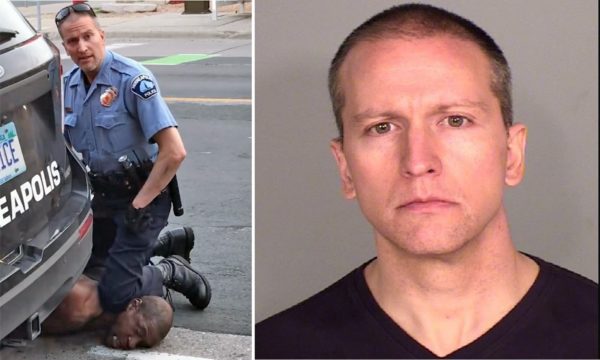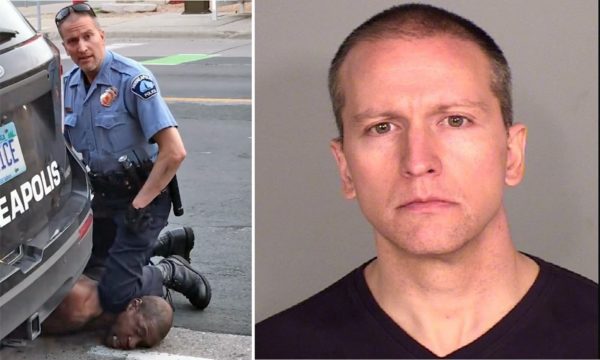‘That’s Just Going to Anger People’: Atlanta Attorney Shares Commentary on Opening Week of Derek Chauvin Trial and the Defense’s Strategy to Shift Blame
An emotional first week of testimony in the murder trial of former Minneapolis police officer Derek Chauvin came to a close Friday.
Chauvin is being tried for counts of second- and third-degree murder, as well as manslaughter in the death of George Floyd Jr. He kneeled on Floyd’s neck for 9 minutes, 29 seconds while trying to make an arrest on May 25, 2020, outside a grocery store following a report Floyd had used a counterfeit $20 bill there.
Thomas Lane, J. Alexander Kueng, and Tou Thao, the three other ex-officers involved, face charges of aiding and abetting second-degree murder and manslaughter. They are scheduled to be tried in August.

“I mean, the system is on trial right now,” Atlanta trial attorney Gerald Griggs told Atlanta Black Star after testimony wrapped up Friday. “And as somebody who’s been in the system for 16 years, I still try to hold out hope that the system will recognize that we are in a reckoning and get it right. I’m bracing for the worst. But again, I’m hopeful as a practitioner of the law. Whatever defense they’re going to put up — he had some type of issue with drugs and the drugs killed him, or he was a big, scary African-American and needed to be restrained — yeah, none of that’s going to work. That’s just going to anger people.”
Griggs is a social activist who works as a criminal defense lawyer. He watched the first week of Chauvin’s trial from afar and touted the strong witnesses. He also said prosecutors have done a good job of humanizing Floyd but feels they need to punch up the emotion in their case.
“The prosecutor has got to tap into that. When he finishes his closing argument, there has to be a cloud of emotion,” Griggs said. “It’s time for the prosecutor to have that same emotion that they have in all those cases where there’s a carjacking, agg assault, or a murder by somebody in the inner city. I need you to keep that same energy.”
Chauvin’s defense attorney Eric Nelson has tried to deflect from the length of time Chauvin knelt on Floyd’s neck and turn the onus back on the slain man. He intends to convince jurors that Floyd died from the combination of a drug overdose and a pre-existing heart condition. During his opening statement, Nelson appealed to the jurors’ “reason” and told them the case should not boil down simply to 9 minutes, 29 seconds.
“Common sense tells you that there are always two sides to a story,” Nelson said Monday. “Common sense tells us that we need to examine the totality of the circumstances to determine the meaning of evidence and how it can be applied to the questions of reasonableness, of actions and reactions.”
In his cross-examinations, Nelson focused on the “growing threat” that the angry crowd of bystanders posed to Chauvin and his three colleagues. Seeing how the officers were handling Floyd, the throng insulted the police and demanded Chauvin get off Floyd’s neck and check his pulse. Yet Nelson’s goal is to show that the crowd distracted the policemen from tending to his health.
Griggs said it’s common for defense attorneys in police brutality cases to attempt to portray the victim as the perpetrator. But he was puzzled by Nelson’s tactic to target the witnesses.
“I didn’t quite understand the strategy of trying to say that the six onlookers were a threat to the law enforcement officer,” he said. “He had his knee on George’s neck for 9 minutes, 29 seconds. I didn’t really understand how that’s going to help your client. But I think that they’re doing as best they can to ignore the tape and, you know, try to blame it on some other things.”
Griggs suggested a more logical tactic for the Chauvin’s defense would be to create reasonable doubt by arguing that his actions were reasonable, given the circumstances. But even that comes with some risk to the former officer.
“If there is a defense in this case, it’s that the state can’t prove beyond a reasonable doubt that Derek Chauvin intended to kill George Floyd. That’s the defense,” Griggs said. “But the only way that you can make that defense, you’ve got to hear it from the defendant. The tape speaks for itself, so we’ve got to get inside his mind. What was he actually intending at that moment. And trust me, you don’t want to put Derek Chauvin on the stand. Because if you put him on stand and I’m the prosecutor, I play the tape. Let us go through this blow by blow.”
Charles McMillian was the first bystander who happened upon the confrontation as officers struggled with Floyd outside the Cup Foods grocery store. He testified Wednesday about how he tried to defuse the scuffle by talking directly to Floyd, urging him to cooperate with the officers.
“You can’t win,” he advised Floyd.
McMillian told prosecutors he’s had his own encounters with police and said he was trying to help Floyd do what he could in the moment to lighten the tense situation. But as the tensions escalated, McMillian began admonishing officers to show restraint and let Floyd up so he could breathe.
“Bro, with your knee on his neck, man, you can get off his neck,” he shouted to Chauvin. “Yeah, that’s wrong right there with your knee on his neck.”
After watching Floyd deteriorate over several minutes, McMillian called Chauvin a “maggot.” The 61-year-old man broke down and sobbed on the witness stand when prosecutors replayed surveillance video and bodycam footage, in which Floyd pleaded for his mama.
“I felt helpless,” McMillian said as he wept. “I don’t have a mama either, so I understand him.”
Griggs said McMillian’s outpouring was the most powerful moment of the week, and will have an impact on jurors.
“There comes a time in most trials, when there’s a witness or a moment, that sucks the air out of a trial,” he said. “Anytime you don’t cross-examine a witness and you let that level of emotion hang over a court room, your client’s go into prison.
“It takes a lot for a Black man to break down and start crying on international television,” Griggs added. “I mean, this was a 60-year-old man who broke down and started crying. That doesn’t happen in our community. And that shows you the level of pain.”
The Minneapolis police officers used a “maximum restraint technique” to quell Floyd. The department trained officers to use the technique on combative suspects in handcuffs, but advised officers to monitor the restrained suspect’s condition and move them into a recovery position as soon as possible.
Minneapolis Lt. Richard Zimmerman, an investigator who’s served more than 35 years in the police department, took the stand Friday. He testified that Floyd had stopped resisting and there was no need for officers to sustain the level of force they were applying once he’d been handcuffed.
“Pulling him down to the ground facedown and putting your knee on his neck for that amount of time, it’s just uncalled for,” Zimmerman said while being questioned by Assistant Attorney General Matthew Frank, the lead prosecutor. “I saw no reason why the officers felt they were in danger, if that’s what they felt. And that’s what they would have to feel to be able to use that kind of force.”
Throughout the week, prosecutors used video to hammer home the tragedy of the police encounter. They played for jurors cellphone recordings filmed by onlookers, surveillance video from surrounding businesses and bodyworn camera footage from the officers who responded to the call. In the videos, the officers showed a callous disregard for Floyd’s life in the moments leading up to his death.
“This is why you don’t do drugs, kids,” Thao quipped to the crowd of bystanders that gathered on the sidewalk in protest as Chauvin knelt on the man’s neck.
“He is human, bro,” Donald Williams told the officer as Floyd struggled, moments before he became unresponsive.
“He’s talking, so he’s fine,” Thao said.
Williams, a mixed-martial arts fighter, was the most vocal of the bystanders in expressing his outrage. He shed tears in the courtroom Tuesday while listening to an audio recording of himself calling 911 on Chauvin and the other officers.
Floyd seemed to be in the throes of a full-blown anxiety attack when the four policemen tried to put him in the back seat of a patrol car. He fought their attempts, saying he was claustrophobic and would rather be restrained on the ground. But Chauvin lodged his knee on Floyd’s throat when the officers wrestled him to the ground. He screamed, cried and pleaded for his life from the pavement.
“They gon’ kill me, they gon’ kill me,” Floyd repeated with bated breath. “I can’t breathe.”
He’d been pinned under Chauvin’s knee for several minutes at that point. Kueng, the youngest of the four officers, suggested they reposition Floyd. It was the 26-year-old rookie’s third shift on the police force, according to The New York Times.
“Roll him on the side?” he asked.
“No, staying put where we got him,” Chauvin, a 19-year veteran, casually replied.
Lane, the other officer helping to restrain Floyd, agreed. “No, leave him,” he said.
“I just worry about the excited delirium or whatever,” Kueng said.
“Well that’s why we have the ambulance coming,” Chauvin insisted.
Moments later, Floyd fell unconscious and went limp.
“I think he’s passing out,” said Kueng, who is Black.
Chauvin didn’t respond. He kept his knee pinned squarely against Floyd’s neck for another four minutes.
“If a prosecutor knows how to connect with a jury, it’s not hard to convince 12 people of what’s caught on video,”Griggs said. “Logic and reason tells you if you keep your knee somebody’s neck for 9 minutes, and 29 seconds you meant to kill them. So don’t let them make excuses. Don’t let them distract you.”

